With new apps or software popping up every day, it’s hard to decide what to introduce into your student’s practice routine. The following list are apps and software I use everyday regularly.
What you prefer and what apps you prefer is a bit of trial and error. Most of these apps have multiple uses but I have my own favorites that I use in different situations.
Metronomes
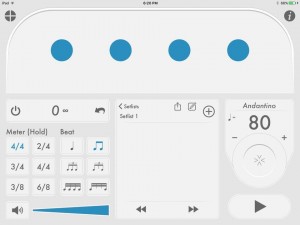 This is my favorite metronome app in my studio and on the road. It is very easy to use and has enough features to make having the “Dr.Beat,” unnecessary and way over priced, although I still love the “good Dr.” when I am practicing at home!
This is my favorite metronome app in my studio and on the road. It is very easy to use and has enough features to make having the “Dr.Beat,” unnecessary and way over priced, although I still love the “good Dr.” when I am practicing at home!
Tempo (iOS – $1.99 & Android – $.99) and its more full-featured sibling Tempo Advance (iOS only – $2.99) is another popular metronome app. It offers the usual range of features, from a variety of time signatures and compound meters to saving of custom rhythm presents and the ability to keep the metronome going even when your device is locked or running another app. The Advance version adds additional customization options and nice little touches like the ability to control the volume of the app independent of the phone’s volume.
Tuners
TonalEnergy
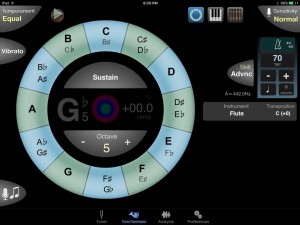 This app is my choice for tuners when working with my students. The smiley face is always appreciated by my students, young and old. The ability to have the app sustain a pedal tone is great when working in the Taffanel and Gaubert. The ability to adjust the settings to different tuning schemas is also useful for period tuning etc. A really useful app for working on tuning intervals and scales!
This app is my choice for tuners when working with my students. The smiley face is always appreciated by my students, young and old. The ability to have the app sustain a pedal tone is great when working in the Taffanel and Gaubert. The ability to adjust the settings to different tuning schemas is also useful for period tuning etc. A really useful app for working on tuning intervals and scales!
The interface is a bit difficult to get used to but well worth the time. I also love the green smiley face that appears when a note is just right. We could all use a little encouragement from time to time right?
TonalEnergy Chromatic Tuner and Metronome (iOS only – $3.99) The tuner responds to all instrument types in the pitch range from C0 to C8. Features include the target tuner display, a dedicated string tuning screen, eight octave keyboard (iPad only), chromatic wheel, and a tone generator that includes high quality multi-sampled instruments for symphonic brass and woodwinds, which is unique among all other tuning applications.
iStrobeSoft
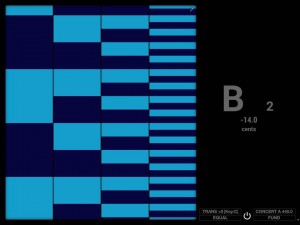 This app is a bit pricier than the others but it is the app version of those really expensive strobe tuners made by the same company. I have used this app to tune the piano in my home studio and it is the app I use to tune my flute ensemble. It is very responsive and extremely accurate. I remember using the strobe tuner in my high school band room back in the day. One draw back might be that students have to be taught how to read this tuner unlike some of the other apps.
This app is a bit pricier than the others but it is the app version of those really expensive strobe tuners made by the same company. I have used this app to tune the piano in my home studio and it is the app I use to tune my flute ensemble. It is very responsive and extremely accurate. I remember using the strobe tuner in my high school band room back in the day. One draw back might be that students have to be taught how to read this tuner unlike some of the other apps.
Peterson’s iStroboSoft (iOS – $9.99; Android – $9.99) Peterson Strobe Tuners’ popular StroboSoft tuning application for the iPod touch® and iPhone™. iStroboSoft™ offers the unmatched accuracy of a mechanical strobe tuner for the highest degree of precision available in a software tuning application.
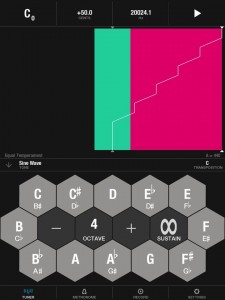 I was introduced to this app by some friends from Wildacres and the Flute Society of Washington. I use this app when I am working with students on vibrato. It has a nice, clear graphic to show the variations in the vibrato. The students like it because it becomes a lot like playing a video game as they try to keep the pitch in the center of the screen. You can choose the graphic representation of the sound wave. This app also has a metronome, will sustain a pedal, and has recording capabilities.
I was introduced to this app by some friends from Wildacres and the Flute Society of Washington. I use this app when I am working with students on vibrato. It has a nice, clear graphic to show the variations in the vibrato. The students like it because it becomes a lot like playing a video game as they try to keep the pitch in the center of the screen. You can choose the graphic representation of the sound wave. This app also has a metronome, will sustain a pedal, and has recording capabilities.
Tunable (iOS – $2.99; Android – $1.90) is another combo app, incorporating a tuner, tone generator, metronome, and recording capabilities in a very simple and clean design. Like TonalEnergy, it allows you to set the difficulty level from beginner (within 10 cents of the pitch) to advanced (within 2 cents) and has different temperament settings as well. It has adjustable vibrato settings, and utilizes color (but no smiley face) to indicate how well you are able to sustain a pitch in tune. An out of tune note makes the screen red, and the more in tune and steady your pitch is, the more of the screen turns green. Strangely satisfying. As far as range goes, a tuba player noted that Tunable continues to recognize pitches at the low end of the tuba’s register, past the point where Cleartune conks out.
n-Track Tuner
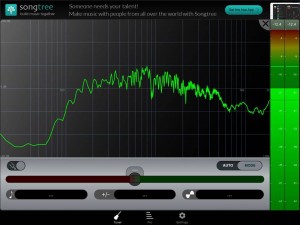 I was introduced to n-Track Tuner app by Danny Dorff. This app has a spectrum analyzer, which allows you to analyze the harmonic content of the tone. This is especially good for focusing on tuning the correct harmonic, specifically on reed instruments with very dense tone like the bass clarinet. I haven’t started using this app with students yet but will be experimenting more with it in the future. It was free so, in the end, if I don’t use it I didn’t lose anything.
I was introduced to n-Track Tuner app by Danny Dorff. This app has a spectrum analyzer, which allows you to analyze the harmonic content of the tone. This is especially good for focusing on tuning the correct harmonic, specifically on reed instruments with very dense tone like the bass clarinet. I haven’t started using this app with students yet but will be experimenting more with it in the future. It was free so, in the end, if I don’t use it I didn’t lose anything.
n-Track Tuner (ios-Free) Tune your guitar, bass or other instrument with n-Track Tuner. Just put your iPhone, iPod Touch or iPad next to your instrument and play each string, the tuner will automatically recognize the note you’re playing and tell you whether you need to lower (green bar) or increase (red bar) the string’s pitch. The spectrum analyzer provides a visual feedback of the notes played by the instrument and shows a small arrow to highlight the harmonic whose pitch the tuner is tracking.
Score Management
Airturn
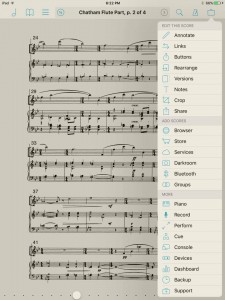 This is my only app for digital music. I have used this app with my Airturn pedals in small and large ensembles, solo performances, and anytime sheet music doesn’t allow for convenient page turns. It is also great for practice on the go since I don’t have to lug tons of music with me. I am still a little partial to actual printed music but this does come in handy quite often. The app connects with Dropbox of ease of loading PDF files and has a pretty comprehensive toolbox for marking the score. It also allows you organize the files, create set lists, and even link the score with an mp3 that might also be on your device. I keep a lot of etudes and warm-ups in the app, as well as a scan of my favorite fingering book, just for emergencies!
This is my only app for digital music. I have used this app with my Airturn pedals in small and large ensembles, solo performances, and anytime sheet music doesn’t allow for convenient page turns. It is also great for practice on the go since I don’t have to lug tons of music with me. I am still a little partial to actual printed music but this does come in handy quite often. The app connects with Dropbox of ease of loading PDF files and has a pretty comprehensive toolbox for marking the score. It also allows you organize the files, create set lists, and even link the score with an mp3 that might also be on your device. I keep a lot of etudes and warm-ups in the app, as well as a scan of my favorite fingering book, just for emergencies!
forScore (iOS $9.99) has the ability to import virtually any PDF file from the web and connect directly to services like Dropbox, it’s not only the best music reader around, it’s also the world’s library of sheet music—just millimeters thick. Keep those scores organized by tagging your files and let forScore do the rest with its dynamic menus that are always up to date. You can also create, share, and play through set lists for a fully manual approach to grouping and arranging your files.
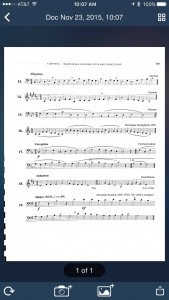 Since I love forScore so much, I needed to have a way to create quick PDF files of scores on the go. This app is amazingly easy to use and very convenient. I have created PDF files of piano parts in minutes without the need for a flatbed scanner. The app plays nicely with other apps and allows for import and export easily. I can scan the score and import it right to forScore on the go. It is perfect for putting pdf files in that already have your markings on to rehearse on the go. Also great for those times when you are without your part for whatever reason!
Since I love forScore so much, I needed to have a way to create quick PDF files of scores on the go. This app is amazingly easy to use and very convenient. I have created PDF files of piano parts in minutes without the need for a flatbed scanner. The app plays nicely with other apps and allows for import and export easily. I can scan the score and import it right to forScore on the go. It is perfect for putting pdf files in that already have your markings on to rehearse on the go. Also great for those times when you are without your part for whatever reason!
Tiny Scanner (iOS – Free) Tiny Scanner – The little app that scans everything: photos, receipts, or just about anything. Lightning fast and gorgeously designed for both iPhone and iPad. Batch mode combines multiple scans into a single PDF. Tiny Scanner turns your iPhone/iPad into a portable scanner. Scans are saved to your phone as images or PDFs. Name and organize your scans into folders, or share them by: Email, Airprint, Dropbox, Evernote, Google Drive, or Box, Wi-Fi directly to your computer, Fax using Tiny Fax
For the heck of it
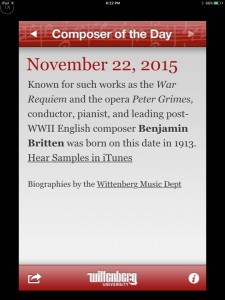 I love this app simply because the nerd in me likes that daily fact. Every day you get a new fact about a composer. I have used this app at the beginning of my theory classes just as a great way to start the lesson. I have frequently shared the daily facts with colleagues and students alike, whether they wanted me to or not!
I love this app simply because the nerd in me likes that daily fact. Every day you get a new fact about a composer. I have used this app at the beginning of my theory classes just as a great way to start the lesson. I have frequently shared the daily facts with colleagues and students alike, whether they wanted me to or not!
Composer of the Day (iOS – Free) WQXR, the most listened-to classical music station in the U.S., named Composer of the Day one of the Top Five Classical Music iPhone Apps! tinyurl.com/wqxr-top5 Read concise, one-sentence biographies of classical composers, one per day, on the composer’s birthday. Learn why Igor Stravinsky was important, what inspired Robert Schumann, what major works Aaron Copland composed, and much more. These composer biographies were created by Prof. Daniel Kazez, with the assistance of music majors and alums at Wittenberg University, a small liberal arts college in Springfield, Ohio. Learn more about Wittenberg: www.wittenberg.edu/music. Send your comments regarding Composer of the Day to dkazez@wittenberg.edu
Recording and editing
Audacity
I love how powerful this software is and the fact that it is FREE! Did I mention that it is FREE? I use this software all the time to record students for audition CDs, record lessons, and edit recital recordings. Of course, the quality of the recording also depends on the quality of the microphones and the other equipment that you use. I actually just used this to record my university’s A cappella choir for a competition and the director was very happy with the end results. This software is perfect for use in a home studio or on the go and has way more functions than most of us will ever need but enough to keep us busy. Generally, the basic functions are pretty user friendly but you will need to use the guide to understand some of the higher functions. They do provide user manuals too! It works for every operating system and did I mention, IT’S FREE!!
Audacity is an easy to use, multi-track audio editor and recorder for Windows, Mac OS X, GNU/Linux and other operating systems. The interface is translated into many languages. You can use Audacity to: Record live audio, record computer playback on any Windows Vista or later machine, convert tapes and records into digital recordings or CDs, Edit WAV, AIFF, FLAC, MP2, MP3 or Ogg Vorbis sound files, AC3, M4A/M4R (AAC), WMA and other formats supported using the optional FFmpeg library
Programs like Audacity are open source software–their source code is available for anyone to study or use.
![]()
What are your favorite apps or software? Comment below.

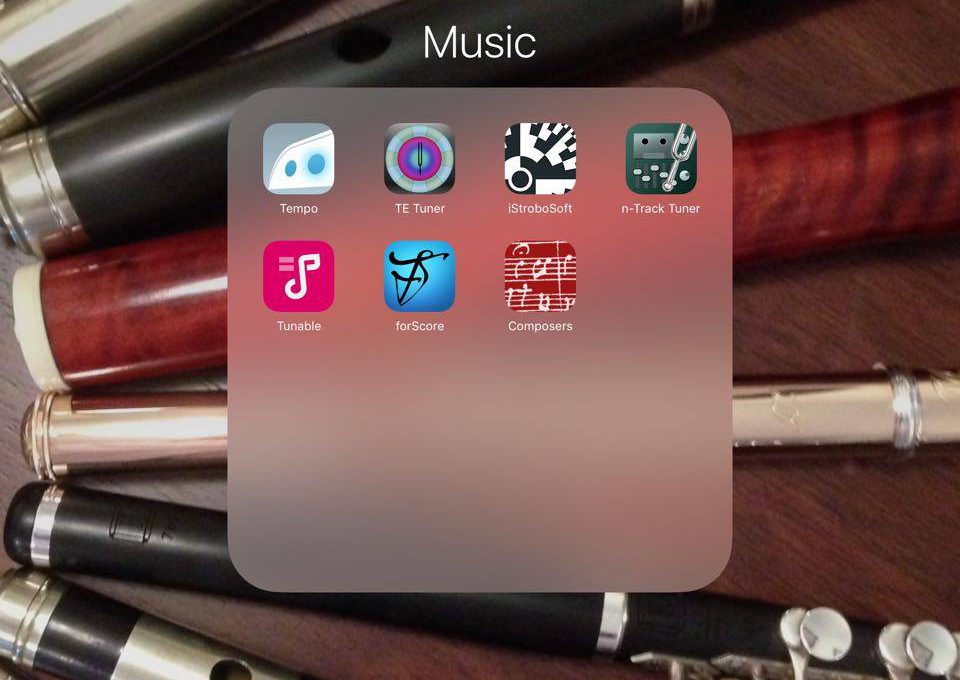
Thanks for the article! I recently switched to Sony SoundForge Audio Studio from Audacity–the (free) trial version is fully functional and its interface is cleaner than Audacity’s. The software can be found at: http://www.sonycreativesoftware.com/download/trials/audiostudio
I have used SoundForge in the past and really liked the layout but the software wasn’t keeping up with the Windows updates at the time AND got rather pricey. There are so many apps out there to cater to everyone these days. The rule of thumb, find the one you like and stick with it. Thank you for sharing this information! Now I will have to look into SoundForge again. 🙂
I’m surprised G-Strings (or Waves) didn’t make it on here as a Tuner app!
Thanks for adding it to the list here! We’ll have to check it out!
Don’t leave us Android users out! Most of the apps you mention are available for Android as well as iOS, but I specifically wanted to mention MobileSheets music reader software. It’s very much like ForScore, but for Android. It’s inexpensive and works wonderfully. Combined with a nice 12″ or bigger tablet,there is not need to printed music ever again if you don’t want.
Also, the Quantz tuner is a lot of fun. Instead of straight lines to tune to, you make the shape look a certain way. For example, a completely round circle is in tune; it flattens out when flat, and gets real skinny vertically when sharp. Kind of a fun way to tune. http://quantztuner.com/
We would never forget our Android users. Thanks for adding this information. I am sure others will find it helpful as well.
Thanks, Laura! 🙂
How about Modacity?
Modacity is a music practice app with:
– practice session planning
– time tracking
– note taking
– statistics & history log
– self-recording w/ 2-16x slower/faster playback
– interactive deliberate practice guidance
– MetroDrone (tunable pulsing drone metronome)
– in-app practice chat
– practice break reminders
– and new features every month
Visit http://modacity.co/ or go to the iOS app store to download for free.
Disclosure: I’m Marc, Co-Founder at Modacity. Within 2 years of applying cognitive science and computer science degrees to French horn, I won my first audition and started an international symphonic career. Performing & teaching career in 20+ countries, I realized that most musicians are missing out on truly efficient practice, and devoted myself to building software to address this problem.
I practice with Modacity every day and get more done in a week than I used to in a month. If you’re a goal-oriented musician, I believe Modacity will serve you well and offer a new level of music practice efficiency.
Android, please, Marc!
Modacity is iPhone only. On iPad it just scales up the iPhone version but is still portrait mode only. Also it requires you to create an account bevor you can try out it‘s features. That‘s a big no go. I‘m deleting this app right now.